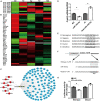Regulation of Schwann cell proliferation and migration via miR-195-5p-induced Crebl2 downregulation upon peripheral nerve damage
- PMID: 37469605
- PMCID: PMC10352107
- DOI: 10.3389/fncel.2023.1173086
Regulation of Schwann cell proliferation and migration via miR-195-5p-induced Crebl2 downregulation upon peripheral nerve damage
Abstract
Background: Schwann cells acquire a repair phenotype upon peripheral nerve injury (PNI), generating an optimal microenvironment that drives nerve repair. Multiple microRNAs (miRNAs) show differential expression in the damaged peripheral nerve, with critical regulatory functions in Schwann cell features. This study examined the time-dependent expression of miR-195-5p following PNI and demonstrated a marked dysregulation of miR-195-5p in the damaged sciatic nerve.
Methods: CCK-8 and EdU assays were used to evaluate the effect of miR-195-5 on Schwann cell viability and proliferation. Schwann cell migration was tested using Transwell and wound healing assays. The miR-195-5p agomir injection experiment was used to evaluate the function of miR-195-5p in vivo. The potential regulators and effects of miR-195-5p were identified through bioinformatics evaluation. The relationship between miR-195-5p and its target was tested using double fluorescence reporter gene analysis.
Results: In Schwann cells, high levels of miR-195-5p decreased viability and proliferation, while suppressed levels had the opposite effects. However, elevated miR-195-5p promoted Schwann cell migration determined by the Transwell and wound healing assays. In vivo injection of miR-195-5p agomir into rat sciatic nerves promote axon elongation after peripheral nerve injury by affecting Schwann cell distribution and myelin preservation. Bioinformatic assessment further revealed potential regulators and effectors for miR-195-5p, which were utilized to build a miR-195-5p-centered competing endogenous RNA network. Furthermore, miR-195-5p directly targeted cAMP response element binding protein-like 2 (Crebl2) mRNA via its 3'-untranslated region (3'-UTR) and downregulated Crebl2. Mechanistically, miR-195-5p modulated Schwann cell functions by repressing Crebl2.
Conclusion: The above findings suggested a vital role for miR-195-5p/Crebl2 in the regulation of Schwann cell phenotype after sciatic nerve damage, which may contribute to peripheral nerve regeneration.
Keywords: Crebl2; Schwann cell; miR-195-5p; migration; peripheral nerve injury; proliferation.
Copyright © 2023 Li, Wu, Zhang, Chen, Wu and Wang.
Conflict of interest statement
The authors declare that the research was conducted in the absence of any commercial or financial relationships that could be construed as a potential conflict of interest.
Figures







Similar articles
-
Long non-coding RNA MALAT1 promotes the proliferation and migration of Schwann cells by elevating BDNF through sponging miR-129-5p.Exp Cell Res. 2020 May 1;390(1):111937. doi: 10.1016/j.yexcr.2020.111937. Epub 2020 Mar 2. Exp Cell Res. 2020. PMID: 32135165
-
miR-485-5p suppresses Schwann cell proliferation and myelination by targeting cdc42 and Rac1.Exp Cell Res. 2020 Mar 1;388(1):111803. doi: 10.1016/j.yexcr.2019.111803. Epub 2019 Dec 24. Exp Cell Res. 2020. PMID: 31877301
-
Down-regulation miR-146a-5p in Schwann cell-derived exosomes induced macrophage M1 polarization by impairing the inhibition on TRAF6/NF-κB pathway after peripheral nerve injury.Exp Neurol. 2023 Apr;362:114295. doi: 10.1016/j.expneurol.2022.114295. Epub 2022 Dec 6. Exp Neurol. 2023. PMID: 36493861
-
Dysregulated miR-29a-3p/PMP22 Modulates Schwann Cell Proliferation and Migration During Peripheral Nerve Regeneration.Mol Neurobiol. 2022 Feb;59(2):1058-1072. doi: 10.1007/s12035-021-02589-2. Epub 2021 Nov 27. Mol Neurobiol. 2022. PMID: 34837628
-
Increased levels of miR-3099 induced by peripheral nerve injury promote Schwann cell proliferation and migration.Neural Regen Res. 2019 Mar;14(3):525-531. doi: 10.4103/1673-5374.245478. Neural Regen Res. 2019. PMID: 30539823 Free PMC article.
Cited by
-
Metal-Based Regenerative Strategies for Peripheral Nerve Injuries: From Biodegradable Ion Source to Stable Conductive Implants.Biomater Res. 2025 Jul 22;29:0219. doi: 10.34133/bmr.0219. eCollection 2025. Biomater Res. 2025. PMID: 40697648 Free PMC article. Review.
References
-
- Allodi I., Udina E., Navarro X. (2012). Specificity of peripheral nerve regeneration: interactions at the axon level. Prog. Neurobiol. 98 16–37. - PubMed
-
- Ambros V. (2004). The functions of animal microRNAs. Nature 431 350–355. - PubMed
-
- Bosch-Queralt M., Fledrich R., Stassart R. M. (2023). Schwann cell functions in peripheral nerve development and repair. Neurobiol. Dis. 176:105952. - PubMed
-
- Diener C., Keller A., Meese E. (2022). Emerging concepts of miRNA therapeutics: from cells to clinic. Trends Genet. 38 613–626. - PubMed
LinkOut - more resources
Full Text Sources

